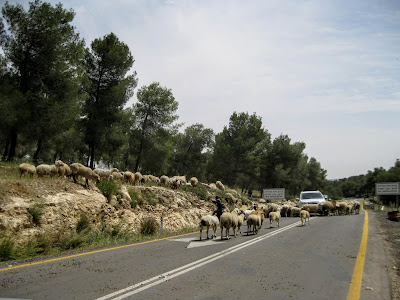.
I got to participate in a lovely iftar this week, my first!
No, it wasn't in this big Bedouin hospitality tent, but it WAS in the courtyard of the new buildings next to it.
It was at Project Wadi Attir, a new and growing Bedouin + Jewish sustainability initiative in the Negev desert.
If you enlarge this photo all the way, you can see the modern and clean sheep and goat shed.
One of their ways to have income is to make and sell cheese.
Traditional Bedouin medicinal herbs and cosmetics are another.
Here is the courtyard where we assembled and later, at sundown, ate.
The iftar was in collaboration with
Women Wage Peace, a multi-faith non-political movement formed by women in the aftermath of the big 2014 conflict with Gaza.
They arranged a panel discussion by a Muslim of Wadi Attir, a Polish Catholic priest from Beer Sheva, and a woman rabbi, who presented the different attitudes and approaches to religious fasting.
On the left: Lina Alatawna, the new young (!) female (!!) Bedouin Director General of Project Wadi Attir--a big success story! See here:
http://www.sustainabilitylabs.org/wadiattirnews/lina-alatawna-named-general-manager-of-pwa/
On the right: "Ghadir Hani, formerly our Executive Secretary, has begun working with Ali in the Field Crops department, managing outreach and sales, and helping with special programs. In addition to farmer's markets, Ghadir has also been introducing the products to new markets through word-of-mouth marketing events in people's homes in nearby neighborhoods like Omer, and has been a fixture at special local events..." quoted from the
April newsletter.
The man wearing a kipa is my town Meitar's mayor; he also spoke, as did the mayor of our neighboring Bedouin town, Hura.
While the adults heard the talks, the Bedouin kids and their young Jewish guests made squares for a peace quilt out in the tent.
The following day, Unity Day in Israel, this happened (quoted from Women Wage Peace English Facebook page):
Unity Day at the Women Wage Peace Mothers’ Tent outside the Knesset
=================
On June 6th, Unity Day, we will spread out 150 quilts which were sewn from thousands of Pieces for Peace which we received from all over the world; we will then create a human chain of unity, and will express our common longing for peace; later Yael Decklebaum will join us at the tent and will sing her songs and talk about her journeys to peace; we will sing the Prayer of the Mothers with her.
1-4 PM Presentation of the Peace Quilts in the Rose Garden
4 PM A human chain along the street leading to the Knesset
After all was said and done, the sun set and we hastened outside to the waiting tables full of good food (some prepared by the hosts and some brought by us guests).
The Muslims dug in without hesitation.
They had been fasting from food AND water from before 4:00 a.m. until 7:47 p.m.!
I can't imagine having that kind of self-discipline and devotion for the entire month of Ramadan, which often falls during our very hot summer.
.
Here is a nice explanation from "
What You Should Know Before Attending Your First Iftar."
The fast itself is considered a purification of sins and a time to cleanse mind, body, and soul. Feeding a fasting person is believed to come with great reward from God and therefore many individuals, organizations, mosques, and community centers will offer an Iftar gathering in which the breaking of the fast is celebrated. It's usually not a ceremonial affair, although at many community gatherings this is often seen as an opportunity to educate and create an inter-faith gathering with delicious food, friends, and conversation.
Ramadan kareem!
(This blessing/greeting means "May you have a generous Ramadan," i.e. be generous in your giving to others.)
.
(Linking to
inSPIRED Sunday.)
.





















































